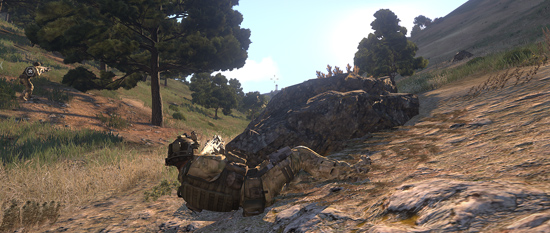At long last, following two years of delays from the initial expected release date ArmA 3 is now available. However, despite the many improvements to the Real Virtuality engine in its fourth version; my excitement passed quickly, like a father to his son that has fallen short in his life’s endeavors, I’m not mad just disappointed.
When I first saw what Bohemia Interactive had envisioned and developed for ArmA 3, prospects for the title were high and rightfully so. The year was 2011, the month was June, the event was E3. For those that saw the showcase back then you can empathize with that sentimentality, what they had to show looked great.
Two years later, having the perspective of its release condition and the vision behind the game, the expectations from E3 2011 have fallen short as we can now see deficiencies in the game which we were blind to in awe back then.
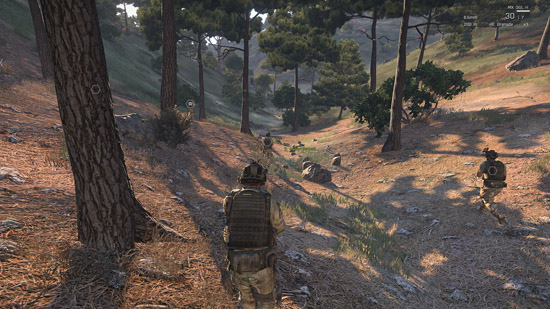
At the time of E3 2011, Bohemia envisioned a high resolution detail the game over and high fidelity character models and vehicle interiors. They wanted the game to be truly beautiful from the uniforms your character could wear to the gear they could equipment and wield, from the vehicles that expedited movement and lethality to the environment which they would drive across or fly over. A new realm would be introduced, one under the sea. From below sea level topography to ambient aquatic life, another focus was an underwater environment as rich as that on land. Overhauls to physics would focus on volumetric effects for both clouds and smoke, along with collisions, dynamic animations rather than scripted, and a new flight model adapted from Take On Helicopters. Network infrastructure was on the docket along with improvements to the FSM schedule which dictated AI command and control.
Today we can see that focus outright in ArmA 3. However, the tunnel vision of that focus from E3 2011 has led to many aspects of ArmA 3 which have been neglected and thus not improved upon since its predecessor, leaving community developers with the task of improving neglected features and functionality.
The Flight Model
We got an early preview of the ArmA 3 flight model with the release of Take On Helicopters, which has been out for almost two years. However, being a helicopter-centric experience the flight physics focused on rotory-powered craft, as one would expect. For a military simulator helicopters aren't enough to paint full picture of armaments and capabilities. Since ArmA 3 is set slightly into the future, more than one piloted fixed wing aircraft was expected as a native asset to the game. That didn't happened, instead there is the Buzzard, which as a partially fictional aircraft is as inspired as a white toast breakfast with no butter or jam; an aircraft with a bland aesthetic. Though the game launched with a UAV, aerial combat pilots are limited to a single aircraft which will make target designation difficult as they must identify friend and foe based one the color of the aircraft rather than it’s aesthetic while flying at hundreds of miles of hour.
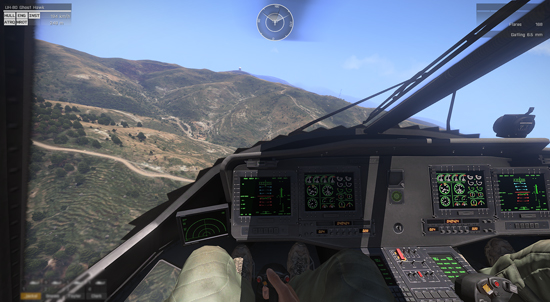
Infantry Woes
The infantry have also suffered some neglect. Though the new stances add extra dimensions to firing around cover or providing a stable shooting platform, much of the equipment which they work with seems as if it was copy and pasted from ArmA 2. Operating at night presents some hazards naturally, with night vision goggles the greatest hazard is nullified, you can still see with high detail and contrast. However, sources of light negate the benefit of these night-time optics as the light pollution they emanate washes your view to a point of blinding. This is why sensitivity adjustments are absolutely necessary for night vision goggles, as they allow you to manage the degree to which light pollution blinds your narrowed and limited view. ArmA 3 has no native sensitivity, despite community requests during the beta period. For boots on the ground returning fire to an enemy within your vision’s wash presents the difficulties of not being able to see your target well while also not being able to simply shoot at their muzzle flashes.
Vehicle weapon systems also do not have a native fire control system. Instead vehicle gunners are left with a constantly updating laser range finder forcing them to learn quickly how to tap-dance on their Page Up and Page Down keys for adjusting the range of their weapon on the fly all the while controlling the weapon with their mouse. Another problem this presents is that the zeroing adjustment is set at 100 meter intervals making firing on targets in between that interval a guessing game until you've become acquainted with the sight. None-the-less an FCS for acute precision would have been a welcomed additions to the native client.
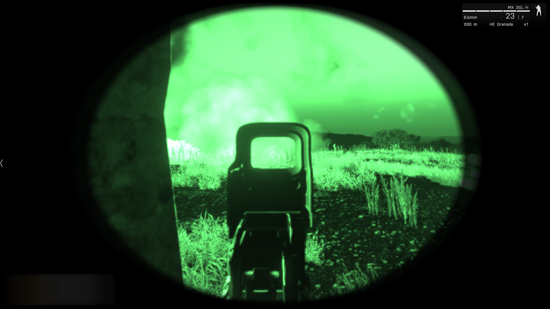
Other Shortcomings
The game also did not release as a full package. Though ArmA throughout its three releases has been played mostly as a multiplayer experience more than a single player experience, the lack of a campaign with the promise of official campaigns releasing later this month as DLC rather than at launch was not well received. Though it wasn't insulting to click into the campaign menu only to be greeted with a message detailing its later release, it was another aspect of the shortcomings for ArmA 3 that made you sigh and shake your head.
Despite their focus on a high fidelity environment with high resolution detailed vegetation, trees still lack volume. Instead of the two-dimensional wash of trees in ArmA 2, the trees appear to be conjunctions of perpendicular two-dimensional images which clash with the highly detailed of environment from topography to shrubbery.
As for menu functionality, Player Profiles still cannot have defined and specified mod packs which would be great considering that many ArmA communities use different mod packs for their servers. For those that have dealt with this before, the easiest way to set a specific modpack for a given server outside of third-party software is to create a shortcut with a mod line that defines the specific mods you wanted it to run. If you played on a few servers, you had quite a few ArmA 2 shortcuts to navigate and manage; unless you single-handily activated and deactivated the mods you wanted through the Expansions sub-menu of the main menu before finding a specific server in the multiplayer browser, presenting yet another hassle.
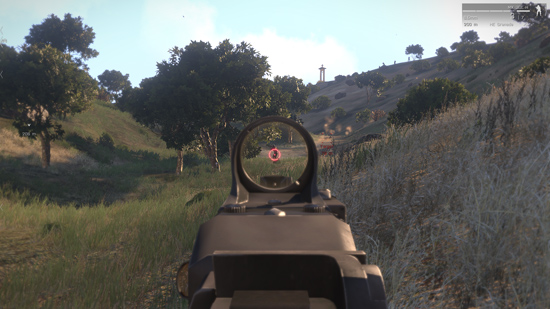
Despite these shortcomings, ArmA 3 has many quality improvements over its predecessors along with added dimensions to gameplay. Which in the end provides a fantastic milsim platform, especially if you have the patience to wait on the community development for extra content and modified features and functionality..
Nuances of Improvement
The new game engine aside, ArmA 3 has aspects of improvement from the macro to micro scale yet it is those nuanced improvements which players see so often whether they realize it or not that provide a breath of fresh air to ArmA players. Long distance optics are now peripheral as the Red Orchestra series and Battlefield 3, a welcomed addition to a game which has come to default on optical attachments. Driving is much smoother and more responsive, vehicles don’t tend to drift off-course during turns as they did in ArmA 2. Improvements to the FSM scheduler allow for AI to break down organization to buddy teams which opens up their ability to conduct fire team flanking maneuvers heightening the tactical side of gameplay the milsim genre demands; failure to adapt to these changes in AI will, I assure you, lead to many calamitous ends to missions you play. The underwater environment adds an additional scale to the milsim; though still in its infancy as there are no ships to destroy, it adds a new way to insert into and exfiltrate from an area of operations expanding approach options, wait for Seal missions to start popping up in the Steam Workshop. Yet another welcomed addition is Steam Workshop compatibility and integration. This tried, tested, and proven content distribution method is perfect for the community-driven experience that is ArmA as it provides a streamlined route of access to missions and modifications along with an automated system for downloading and updating these missions and mods. Grenade physics are also more functional. Instead of lobbing grenades in a high arc the parabolic trajectory has been greatly reduced finally allowing for deliberate tosses into bunkers, builds, or bouncing them off walls and through windows.
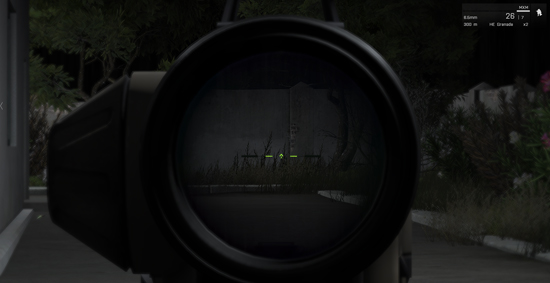
New Engine
One thing we've come to know about ArmA, is that when a new title is released the backbone of the game is also brand new. Now on its fourth version, the Real Virtuality engine used for ArmA 3 is gorgeous. As we've come to expect over the last two years since the E3 2011 showcase, developing a high resolution graphical experience through the new technologies of the game engine was a key focus for the team and they have achieved a high watermark for quality this time around. Lighting effects paint a large pallete of colors and glare while casting volumetric shadows. High resolution textures from character models and the equipment they wield to the environment’s topography, flora (excluding the ugly trees), and fauna present a stunning visual experience. Along with high fidelity interiors to vehicles from their instrument panels to communications equipment and even gunner positions outfitted with a viewing screen for their weapon and a dashboard for controls including a joystick with hands-on; Bohemia came through on their promise to simulate a thorough visual aesthetic.
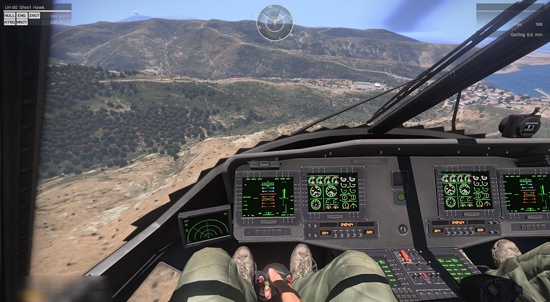
Improvements to the engines' physics especially in regards to collisions has come to surprise me the more I spend on their massive 290 square kilometers sprawl of landmass between the two islands. Much of the static infrastructure is highly destructible. Gone are the days of weathering a mortar or artillery barrage in the safety of a building; now the building is coming down following a direct hit. Ballistically with the correct caliber and angle one can kill through walls, yes plural. The sound engine is marvelous. High fidelity sound modulation over distance, between objects or terrain features, on land, or underwater allows for sounds to augment depending on not only your environment but also the infrastructure you are in or around. It is also loud. Explosions sound great whether coming from a tank firing or that round impacting along with explosive charges or mines; the magnitude of an explosion can be well gauged by the sound it produces in game. When an armored vehicle is hit and explodes, not only will you hear the explosion from the impact but ammunition from inside the vehicle will also cook off producing a prolonged procession of pops as the rounds explode inside their compartment. If you play with speaks, pump your bass before blowing something up; though alter your neighbors first.
After two years of delays and a 128 day fiasco involving the incarceration of two Bohemia employees in Greece a year ago (including the Creative Director for ArmA 3), it is finally here. Despite the shortcomings of development, as what released is not as thorough or verbose as expected given the years of extra development cycle; many improvements have been made not only to the engine but gameplay as well. FSM scheduler optimization will present a greater threat for co-operative missions that pit players against the AI while Steam Workshop integration provides a hassle-free distribution method of community-made content, the true driving force behind the ArmA series. In the end ArmA 3 provides yet again the best platform and sandbox for military simulator enthusiasts; though many ArmA communities still play ArmA 2 as their primary game, in time community development will pave the way for ArmA 3 as the standard we just have to wait for the mods we've come to play with as a default experience to release.
